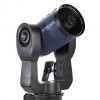Meade LX200-ACF 8 inch User Manual - Page 49
Inspecting the Optics, Gauging the Movement of the Telescope, Meade Consumer Solutions Service
 |
View all Meade LX200-ACF 8 inch manuals
Add to My Manuals
Save this manual to your list of manuals |
Page 49 highlights
Fig. 34: R.A. Lock. Fig. 35: Dec Lock. i. As a final check of alignment, examine the star image in focus with the higher power eyepiece as suggested (h), under good viewing conditions. The star point should appear as a small central dot (commonly referred to as an "Airy disc") with a diffraction ring surrounding it. To give a final precision collimation, make extremely slight adjustments of the three set screws, if necessary, to center the Airy disc in the diffraction ring. You now have the best alignment of the optics possible with this telescope. Inspecting the Optics A Note about the "Flashlight Test": If a flashlight or other high-intensity light source is pointed down the main telescope tube, the view (depending upon the observer's line of sight and the angle of the light) may reveal what appear to be scratches, dark or bright spots, or just generally uneven coatings, giving the appearance of poor quality optics. These effects are only seen when a high intensity light is transmitted through lenses or reflected off the mirrors, and can be seen on any high quality optical system, including giant research telescopes. The optical quality of a telescope cannot be judged by the "flashlight test;" the true test of optical quality can only be conducted through careful star testing. Gauging the Movement of the Telescope A common complaint of many first-time motorized telescope owners is that they cannot see the telescope "move" when the motor drive is engaged. If fact, when the batteries are installed, the power is on and the R.A. lock (Fig. 34) engaged, the telescope is moving. However, the movement is at the same speed as the hour hand of a 24-hour clock; as such, the movement is difficult to discern visually. To check the movement of your telescope, look at an astronomical object through the telescope's eyepiece with the telescope aligned and with the motor drive on. If the object remains stationary in the field of view, your telescope is operating properly. If not, check to ensure that you have engaged the R.A. lock and that the power switch on the control panel is on. Meade Consumer Solutions Service If you have a question concerning your LX200-ACF, contact the Meade Instruments Consumer Solutions Department at: Telephone: (800) 626-3233 Customer Service hours are 7:00 AM to 5:00 PM, Pacific Time, Monday through Friday. In the unlikely event that your LX200-ACF requires factory servicing or repairs, write or call the Meade Consumer Solutions Department first, before returning the telescope to the factory, giving full particulars as to the nature of the problem, as well as your name, address, and daytime telephone number. The great majority of servicing issues can be resolved by telephone, avoiding return of the telescope to the factory. If factory service is required, you will be assigned a Return Goods Authorization (RGA) number prior to return. LX200-ACF TIPS What is Smart Drive? Smart Drive is a feature that allows you to train almost all of the periodic error from the R.A. and Dec. motor drive worm gears. Periodic error is brought about by tiny gear imperfections. These imperfections exist in all manufactured worm gears. These imperfections tend to ever so slightly speed up or slow down the drive tracking speed during each rotation of the worm gear. This inconsistency in the tracking rate can have a negative effect on astrophotography. Smart drive lets you train your telescope system to compensate for these inconsistencies and, as a result, perform more accurate tracking during astrophotography. Smart Drive remembers the training even after the telescope is turned off. If you'd like to learn more about about Periodic Error Correction, see page 40. - 49 -















